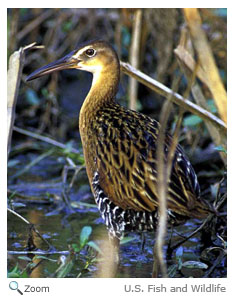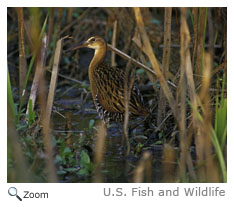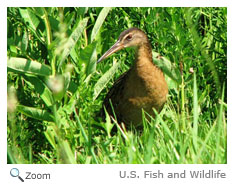Description
 The King Rail is a medium-sized marsh bird with a body that looks like a chicken. Its feathers are rust-colored with a speckled pattern on the wings and white spots on the side of its body. The King Rail has a long curved bill, which helps it hunt in weedy marshes. The King Rail is a medium-sized marsh bird with a body that looks like a chicken. Its feathers are rust-colored with a speckled pattern on the wings and white spots on the side of its body. The King Rail has a long curved bill, which helps it hunt in weedy marshes.
Range
Found in the United States, Central America and the Caribbean, the King Rail has a very large range that stretches from the Midwestern United States to the Atlantic Ocean. The King Rail can live in the southern part of its range year-round. In the summer, it migrates to the northern part of its range to breed.
Habitat
 The King Rail prefers freshwater marshes but will use brackish (mixed salt and freshwater) wetlands as well. It is important that the King Rail's habitat have grasses, sedges, rushes and cattails to use as cover during nesting. The King Rail is found in rice fields in the southern United States and coastal saltwater marshes along the east coast. The King Rail prefers freshwater marshes but will use brackish (mixed salt and freshwater) wetlands as well. It is important that the King Rail's habitat have grasses, sedges, rushes and cattails to use as cover during nesting. The King Rail is found in rice fields in the southern United States and coastal saltwater marshes along the east coast.
|
|
Diet
 The King Rail is an omnivore and mostly feeds in the water. It mainly feeds on crustaceans like crayfish, fiddler crabs and clams, fish and insects. Occasionally, the King Rail eats plants and seeds. If it must feed on land, the King Rail will dunk the food in water before consuming it. The King Rail is an omnivore and mostly feeds in the water. It mainly feeds on crustaceans like crayfish, fiddler crabs and clams, fish and insects. Occasionally, the King Rail eats plants and seeds. If it must feed on land, the King Rail will dunk the food in water before consuming it.
Life Cycle  Breeding and nesting occurs between April and July. The female lays between 6-14 light colored eggs. The male and female incubate the eggs for 22 days, taking turns. During this time, the male defends the nest. After hatching, the young can follow their mother around immediately. 4-6 weeks after hatching, the young can forage and feed themselves. After two months, young King Rails are able to fly on their own. Breeding and nesting occurs between April and July. The female lays between 6-14 light colored eggs. The male and female incubate the eggs for 22 days, taking turns. During this time, the male defends the nest. After hatching, the young can follow their mother around immediately. 4-6 weeks after hatching, the young can forage and feed themselves. After two months, young King Rails are able to fly on their own.
Behavior
 After laying their eggs, the adult King Rail molts, sheds its feathers completely and is flightless for nearly a month! After laying their eggs, the adult King Rail molts, sheds its feathers completely and is flightless for nearly a month! |





